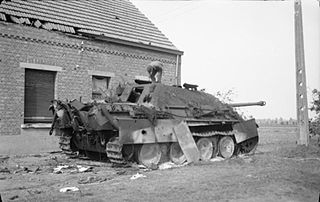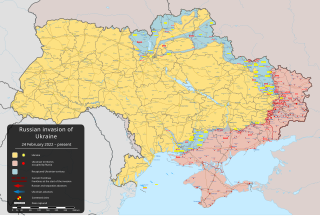A counterattack is a military tactic.
"Counter-Attack" and other variations also may refer to:
A nuke is a nuclear weapon.

The Second Battle of the Marne was the last major German offensive on the Western Front during the First World War. The attack failed when an Allied counterattack, led by French forces and supported by several hundreds of Renault FT tanks, overwhelmed the Germans on their right flank, inflicting severe casualties. The German defeat marked the start of the relentless Allied advance which culminated in the Armistice with Germany about 100 days later.
Counterstrike may refer to:
Yugoslav or Yugoslavian may refer to:

The First Battle of Changsha was the first of four attempts by Japan to take the city of Changsha, Hunan, during the second Sino-Japanese War. Coming two weeks after Germany's invasion of Poland on September 1, it was the first major battle of the war to fall within the time frame of what is widely considered World War II.

A counterattack is a tactic employed in response to an attack, with the term originating in "war games". The general objective is to negate or thwart the advantage gained by the enemy during attack, while the specific objectives typically seek to regain lost ground or destroy the attacking enemy.

The 12th Panzer Division was an armoured division in the German Army, established in 1940.

The 10th SS Panzer Division "Frundsberg" was a German Waffen-SS armoured division during World War II. The division's first battles were in Ukraine in April 1944. Afterwards, the unit was then transferred to the west, where it fought the Allies in France and at Arnhem. The division was moved to Pomerania, then fought south east of Berlin in the Lusatian area until the end of the war.

The 4th Panzer Army, operating as Panzer Group 4 from its formation on 15 February 1941 to 1 January 1942, was a German panzer formation during World War II. As a key armoured component of the Wehrmacht, the army took part in the crucial battles of the German-Soviet war of 1941–45, including Operation Barbarossa, the Battle of Moscow, the Battle of Stalingrad, the Battle of Kursk, and the 1943 Battle of Kiev.

In fencing, an attack is "The attack is the initial offensive action made by extending the arm and continuously threatening the opponent’s target, preceding the launching of the lunge or flèche". In order for an attack to be awarded successfully, the fencer must accelerate their hand towards the target. If the fencer does not accelerate the hand, this is a preparation.
The Battle of West Hunan, also known as the Battle of Xuefeng Mountains and the Zhijiang Campaign, was the Japanese invasion of west Hunan and the subsequent Allied counterattack that occurred between 6 April and 7 June 1945, during the last months of the Second Sino-Japanese War. Japanese strategic aims for this campaign were to seize Chinese airfields and secure railroads in West Hunan, and to achieve a decisive victory that their depleted land forces needed.

Operation Tractable was the final attack conducted by Canadian and Polish troops, supported by a British tank brigade, during the Battle of Normandy during World War II. The operation was to capture the tactically important French town of Falaise and then the smaller towns of Trun and Chambois. This operation was undertaken by the First Canadian Army with the 1st Polish Armoured Division and a British armoured brigade against Army Group B of the Westheer in what became the largest encirclement on the Western Front during the Second World War. Despite a slow start and limited gains north of Falaise, novel tactics by the 1st Polish Armoured Division during the drive for Chambois enabled the Falaise Gap to be partially closed by 19 August 1944, trapping about 150,000 German soldiers in the Falaise Pocket.

The 17th Panzer Division was a formation of the Wehrmacht in World War II. It was formed in November 1940 from the 27th Infantry Division. It took part in Operation Barbarossa, the invasion of the Soviet Union in June 1941, and in the winter of 1941–42 participated in the Battle of Moscow. In November 1942, the division was sent to the southern sector of the Eastern Front where it participated in Operation Winter Storm, the failed attempt to relieve the surrounded troops at Stalingrad. The division was held in reserve during the Battle of Kursk in 1943, and thereafter retreated through Ukraine and Poland, before ending the war in Czechoslovakia.

The siege of Breslau, also known as the Battle of Breslau, was a three-month-long siege of the city of Breslau in Lower Silesia, Germany, lasting to the end of World War II in Europe. From 13 February 1945 to 6 May 1945, German troops in Breslau were besieged by the Soviet forces which encircled the city as part of the Lower Silesian Offensive Operation. The German garrison's surrender on 6 May was followed by the surrender of all German forces two days after the battle.

Battle of Northern Burma and Western Yunnan was the name of the Chinese campaign with their allies in the 1943–45 Burma Campaign. The campaign ended in an Allied victory.

The Upper Silesian offensive was a strategically significant Soviet offensive on the Eastern Front of World War II in 1945. It was aimed at capturing the considerable industrial and natural resources located in Upper Silesia and involved forces of the 1st Ukrainian Front under Marshal Ivan Konev. Due to the importance of the region to the Germans, considerable forces were provided to Army Group Centre for its defence and the Germans were only slowly pushed back to the Czech border. Fighting for the region lasted from mid January right until the last day of the war in Europe on May 8, 1945.

Tactics are very important to playing well in modern fencing and although technique is important in the sport, using an array of tactics will help fencers make the most of that technique.

The Battle of Geel, also known as the Battle of the Geel Bridgehead, was a battle between British and German troops near Geel (Gheel) in Belgium. It occurred between 8 and 23 September 1944 and was one of the largest and bloodiest battles to occur during the first phase of the Liberation of Belgium.

The 390th Rifle Division was an infantry division of the Soviet Union's Red Army during World War II. It was formed twice, first in August 1941, and after its destruction in 1942, re-formed in 1944.

The battle of Davydiv Brid was a Ukrainian counter-offensive operation during the 2022 Russian invasion of Ukraine. Ukrainian forces attempted to recapture part of Russian-occupied Kherson Oblast and tie up Russian resources. The counteroffensive began on 27 May 2022 and was centered near the village of Davydiv Brid, which was initially recaptured by Ukraine; however, they were pushed back over the Inhulets River by 16 June 2022. However, another bridgehead near Lozove was retained by Ukrainian forces. In a subsequent Ukrainian southern counteroffensive that was launched two and a half months later, Davydiv Brid was reported as captured by Ukrainian forces on 4 October.